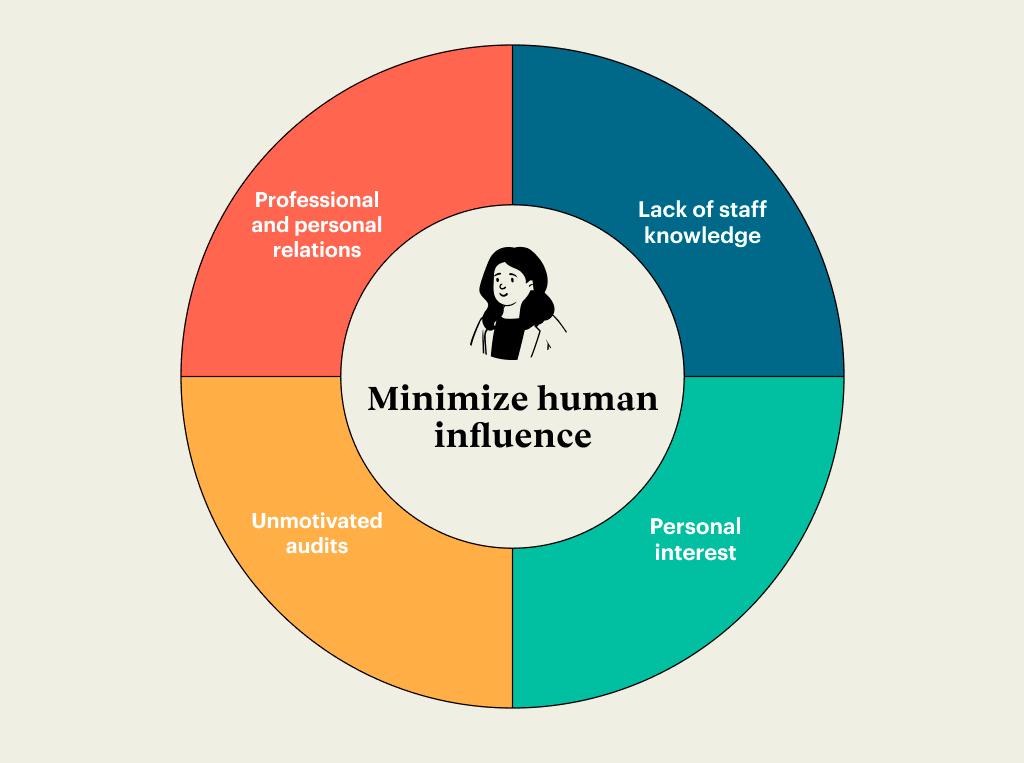Qvalon Blog article content
QVALON monitors and evaluates the quality of compliance with operating standards. Its positive impacts on different business industries and segments are detailed in previous articles (The secret of clean Burger King and Success stories of BILLA). The scope of advantages from these positive impacts depends on how efficiently QVALON is used by employees. Like any other sphere where humans are involved, here also, the objectivity of results is influenced by them. Even if technology is the most innovative, most advanced, as long as it is operated by people, the authenticity of its results or performance is unlikely to be completely free from human influence.

Why reports differ from actual scenarios
We occasionally experience discrepancies between an actual situation and its report. In some extreme cases, we intentionally cause such discrepancies. A diabetic patient may get an insulin shot before their blood test so the report shows normal sugar level. But the actual scenario is different. No matter how quick the report is generated or how advanced the test is, it can easily be manipulated to provide desirable results.
Another example from work life. In the audit report, a store’s lighting is shown fine, but one evening while passing by, badly illuminated mannequins showing the latest offers are observed. So the reason behind fewer sales at that store, as compared with the rest of the retail network is understood.
At times there are no obvious reasons for disagreement between reports and the actual situation. In such conditions, a whole investigation is needed to determine the possible causes that led to the information mismatch. A business does not necessarily have to employ an army of detectives or auditors to solve the case. In most cases, information disagreement is down to inadequate use of QVALON due to lack of knowledge.
The following checklist is helpful to verify if everything is done right.
-
Simple and clear questions
It is important that all audit participants understand the checklist completely. For example, a simple question "Clean showcase" allows a wide range of interpretations. Different auditors will understand it differently and, consequently, will give divergent answers. Obviously, the results of such an audit will be varied.
To avoid this, the way a question is formed is crucial. Like in the "Clean showcase" example, the criteria of cleanliness that are important should be added. So now the revised question becomes “Clean showcase: no scotch marks, no fingerprints, no stains." With this description, it is clear to everyone what needs to be done when cleaning the showcase.
QVALON goes one step ahead and has the ability to set even more precise criteria by attaching a reference photo of a clean showcase. Now, complicated and long questions with their explanations are not a must. Audit participants have a visual representation of the benchmarks against which their work will be measured. Hence there is no room for confusion and it helps with achieving uniform common goals.
-
Questions types to suit your strategy
There are two types of questions that can be asked in QVALON. The first type accepts "yes" or "no" answers only. The second accepts intermediate values (1, 2, 3, 4, and 5) too. Each has its own pros and cons.
The first type of questions are completely clear and allow subsequent result analysis in similar terms, i.e. good or bad. There is no middle ground. But this can also cause dissatisfaction among employees under review. A positive answer to this type of question is possible only in the case of 100% compliance with the standard. If there is even the slightest discrepancy, the answer will be no, which may seem unfair.
The second type of question can be more reasonable, which implies intermediate score options between the extremes. However, this provides a different challenge. Each interim assessment option needs to have its own clear criteria so that each audit participant knows when the shop window is clean enough for 4 points and when for 3. If this is not done, there will be even greater discord between the participants. Most of the time, there will be an objection on the lines of "Why did we get different grades for the same job?"
-
Use advanced QVALON features
QVALON has several tools for increasing the objectivity of data monitoring. The first is a photo report or reference photo which has been mentioned in the first point above. For example, in addition to the merchandising standard, it is enough for the auditor to also attach a photo of the ideal product presentation. This leaves no room for any confusion. If something could not be understood by reading the standard, then it can be easily grasped through reference photographs.
The second tool is geolocation, which determines the true location of the participants during the audit. The system checks the employee's geoposition against the coordinates of the verification object. It can then disable the possibility of conducting an audit if the two locations do not coincide.
-
True insights to verified results
Trends and insights on the quality of key business processes can be drawn only from the analysis of data accumulated over a time period. A one-time audit will show the situation only on the date of the audit. For example, during a one-time store audit, there was a lack of compliance in displaying the new collections. On the first impression, it is easy to conclude that the store manager is not working well and maybe they need to be replaced. But if the results of the same store are analyzed over a time period, it may tell a different story. That may be the store is one of the best performers in the entire network, with the store manager achieving the highest ratings among all other store managers.
QVALON implements two types of reports to analyze the audit results for any time period: tabular reports and visual BI reports. Another convenient tool is the Audit calendar. It helps users develop a regular approach to the audits. Hence audit schedules will not be forgotten when a store is visited.
Minimize human influence

This is probably the most recurring and tricky to correct. As you update technology, the ways humans can influence its performance also update. And not all possible scenarios can be forecasted accurately. Nevertheless, it is necessary to reduce its impact, because if left unattended, then in addition to unreliable audit reports, it can negatively affect a business in many more ways, like:
-
Lack of staff knowledge.
For an auditor to make an objective and reliable assessment of operating activities, they must have updated knowledge of corporate standards, policies, and procedures. If their knowledge is incomplete or outdated, then they might miss violations, or on the contrary, give low scores to correctly performed tasks. In the latter case, there is the risk of propagating a negative work atmosphere and loss of loyalty towards the company from the auditee. -
Professional and personal relations.
If the relationship between the auditor and the auditee is beyond the professional dynamics, the auditor can give a good assessment in advance and turn a blind eye to minor violations. This is not as harmless as it sounds, but regular occurrences of such situations can lead to systemic problems and unprofessional attitudes. -
Unmotivated audits.
The auditor can do a half-hearted audit and give positive answers to the checklist without going into details. As a result, the store teams will lose their vigilance and will be tempted to work carelessly. -
Personal interest.
If bonuses of the entire workforce are dependent on audit results then there is a risk that the auditors will intentionally over-project the final results. If auditors remain outside the scope of reviews then it may lead to undeserved bonuses for false merits.
The easiest way to reduce the impact of the human factor is to conduct audits by another auditor or to apply the "check of auditors" approach. It is important to understand that the store situation never remains the same. On weekly basis, from offers to inventories, work dynamics keep changing. Therefore, with the minimum time delay, a control audit should be carried out using the same checklist.
Extracting intelligence with QVALON
Ignorance can be bliss, but in a business, it can lead to disaster. If there is an absence of objective information, issues cannot be spotted and their timely correction remains unattainable. QVALON helps businesses with audit reports that can be trusted and on the basis of which needed actions can be taken, be it solving problems, calculating payouts, and much more.
At QVALON, our team delivers a personalized, simple, and cost-effective approach to grow your business.



